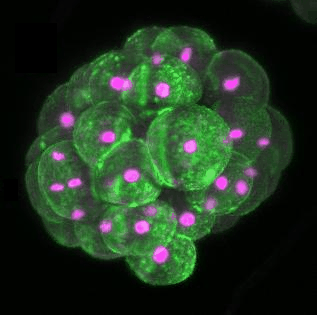[ living matter lab ]
explore our on-going projects here.



symmetry and order in living matter
Living matter at all scales has a remarkable capacity to grow, organize, heal and move. This capacity stems from its ability to convert energy at the molecular scale to generate macroscopic organized motion and emergent structures. The lab's overarching vision is to understand how nonequilibrium forces lead to spatiotemporal organization in living matter, and in turn, how biological regulation harness this self-organizing capacity to make functional forms.
Our lab is curiosity-driven, and we are interested in deciphering how order, symmetries and dynamics emerge in living matter. To do so, we draw inspiration from physics ideas in active matter, nonlinear dynamics and out-of-equilibrium statistical mechanics. By using a variety of model systems (including marine invertebrate embryos and mammalian organoids), the lab combines quantitative imaging, creative data analysis and collaboration with theorists to study the physical basis of biological organization.
our team is recruiting
We are looking for motivated and creative undergraduate/PhD/postdocs to join our team!
In particular, the two active research directions in the lab are:
-
Chiral active matter, with a focus on phase transitions, the role of disorder and collective dynamics using marine invertebrate embryos (e.g. P. miniata, Platynereis) as model
-
Organoid morphogenesis, with a focus on morphological landscape, optogenetics, tissue mechanics and mechanochemical coupling
Our lab is primarily an experimental soft matter/biophysics lab with plenty of opportunities to collaborate with theory groups. We aim to combine experiments with creative data analysis to understand how symmetry, order and dynamics emerge in living matter.
About the department. The successful candidates will join a vibrant, energetic and collaborative research team. Our group is embedded within the Biological Physics division of UCSD Physics department with over 12 experiment/theory groups covering all major areas of biophysics, offering an unparalleled intellectual and collegial environment. UCSD is recognized as one of the top 20 research universities worldwide, and our Physics of Living Systems graduate program is ranked among the top 5 by US News and World Report.
Postdocs. Please email Tzer Han directly with CV and a short statement of interest. We welcome applicants from diverse and international background.
PhD and undergraduate students. Students already at UCSD can contact Tzer Han directly. Otherwise, you can apply to the Physics PhD program here. Deadline Dec 6, 2023.
recent talks
other projects



publication
Emergent chirality in active solid rotation of pancreas spheres.
Tan TH*, Amiri A*, Barandiaran IS*, Staddon M, Hermann A, Tomas S, Duclut C, Papovic M, Julicher F, Grapin-Botton A.
Preprint on bioRxiv (2022). Submitted.
Odd dynamics of living chiral crystals.
Tan TH*, Mietke A*, Li J, Chen Y, Higinbotham H, Gokhale S, Foster PJ, Dunkel J, Fakhri N.
Nature (2022), 607(7918), 287-293
[ News and Views | Nature Video | MIT news | sciencealert.com | New Scientist | Discover magazine ]
Mapping and exploring the organoid state space using synthetic biology.
Tan TH*, Liu J*, Grapin-Botton A.
Seminars in Cell and Developmental Biology (2022). Academic Press.
Polarized Dishevelled dissolution and condensation drives embryonic axis specification in oocytes.
Swartz SZ, Tan TH, Perillo M, Fakhri N, Wessel GM, Cheeseman IM, Wikramanayake I.
Current Biology (2021). 31(24), 5633-5641.
Scale-dependent irreversibility in living matter.
Tan TH*, Watson GA*, Chao YC*, Gingrich TR, Horowitz JM, and Fakhri N.
Preprint on arXiv (2021). Submitted.
A hierarchy of protein patterns robustly decodes cell shape information.
Wigbers M*, Tan TH*, Brauns F, Jinghui L, Swartz Z, Frey E, Fakhri N.
Nature Physics (2021).
Topological turbulence in the membrane of a living cell.
Tan TH*, Liu J*, Miller PW*, Tekant M, Dunkel J, and Fakhri N.
Nature Physics (2020).
[ PDF | Nature Physics cover art | MIT news | phys.org | physicsworld.com | Research highlight in Nature ]
Self-organized stress patterns drive state transitions in actin cortices.
Tan TH*, Malik-Garbi M*, Abu-Shah E*, Li J, Sharma A, MacKintosh FC, Keren K, Schmidt CF and Fakhri N.
Science Advances (2018). 4(6), p.eaar2847.
[ F1000 article recommendation ]
Cho WK, Jayanth N, Mullen S, Tan TH, Jung YJ and Cissé II.
Scientific reports (2016). 6, p.35949.
How grow-and-switch gravitropism generates root coiling and root waving growth responses in Medicago truncatula.
Tan TH, Silverberg JL, Floss DS, Harrison MJ, Henley CL and Cohen I,
Proceedings of the National Academy of Sciences (2015). 112(42), pp.12938-12943.
[ Research highlight in Nature Physics | Cornell Chronicle ]
(*denotes co-first authors)
Google scholar profile here.


